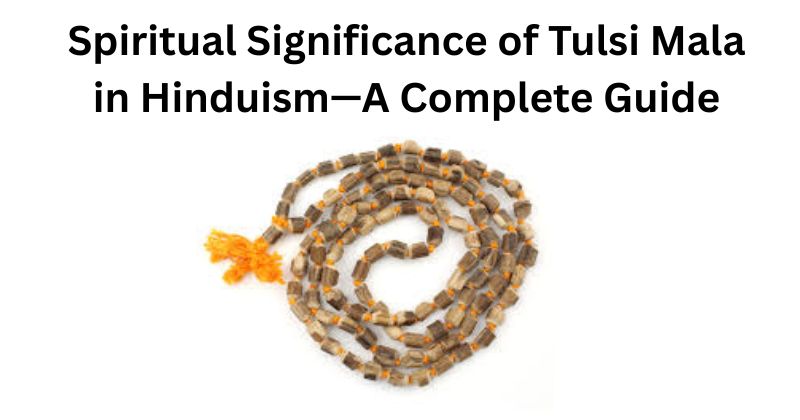In the realm of Hindu spirituality, there are very few objects deemed as holy and potent as the tulsi mala or the original Rudraksha mala. Made from the sacred Tulsi plant, this plain-looking rosary has rich meaning in the world of spirituality and represents purity, devotion, and divine connection.
Tulsi Mala (sacred basil garland) is amongst the highest-regarded items of faith in their use as spiritual accessories throughout India and globally. It has been treasured over the years for both its religious inclusion and therapeutic and spiritual radiance. This blog explores its history, benefits, correct use, and some obscure things you probably didn’t know about Tulsi Mala, an immersive dive into its divine power.
What is Tulsi Mala?
The Tulsi mala is more than just a mala (bead string) because it is made from the sacred herb in Hinduism, which is the sacred basil plant, and is used for meditation and praying. Tulsi is herself a goddess and symbolizes purity and devotion. To wear a Tulsi mala is said to bring spiritual energy, peace of mind, and connectedness to God.
Each of the 108 beads in the Tulsi mala is hand-carved out of the wood or roots of the tulsi plant and symbolises surrender to God and right living. In most Hindu homes, the tulsi plant is worshiped as a sacred plant, and the mala is worn to continue that worship.
What is the importance of Tulsi beads?
Tulsi beads are made from the wood of the tulsi plant and hold special meaning in the Hindu tradition, especially among followers of Vaishnavism.
There are different kinds of tulsi mala, like tulsi kanthi mala, tulsi japa mala, and Shree Ram Tulsi Mala pendant.
Spiritual Importance: Considered sacred to Lord Vishnu and Krishna, and is a sacred plant
It is said that the person is blessed and protected by the divine spirit when worn as an amulet.
Religious Use: Mainly used to chant mantras, usually the Hare Krishna mantra or the Vishnu mantras. Each bead represented one repetition while using the beads for japa.
Cultural Traditions: Especially sacred to ISKCON and Gaudiya Vaishnavism traditions.
Generally presented as a holy gift for use during a festival ceremony.
Spiritual Tulsi Mala Benefits
Enhancing Meditation and Focus: Many people utilise Tulsi Mala for Japa meditation—repeating a name of God or a mantra. The smooth, soft material and pleasant aroma make meditation easier. When using a Tulsi Mala, you will likely notice an increase in your focus and connect better with your spiritual interest/direction.
More Connected to Deities: Hindus believe that the Tulsi plant is the abode of deities. Therefore, wearing a Tulsi Mala while praying or worshipping is like inviting divine blessings. While it looks good, it represents a connection to a chosen deity and a commitment to spiritual practice.
Protect Against Negative Energy: Tulsi Mala acts as a spiritual shield to protect wearers from the evil eye, low vibrations, negative energies, black magic, and all kinds of negative energies. It energetically provides a barrier to keep low vibrations from attaching themselves to you.
Calming the mind: Tulsi offers calming energy, which promotes mental peace and emotional stability. It calms stress, anxiety, emotional turmoil, and erratic feelings. It can help people who overthink and feel restless.
Enhancing Meditation: The most common use of Tulsi Mala is for mantra chanting (japa). When using a Tulsi mala, you will find it easier to focus on your mantra for an extended period. Its presence makes it easier to find a meditative state of mind. It helps organise your thoughts and gets your mind in tune with your spiritual needs and intentions (duality).
Benefits of Wearing Tulsi Mala
Okay, let’s talk about the health side of things because, honestly, who doesn’t love a good wellness boost? Here are some common benefits of wearing a Tulsi mala:
Boosting Your Body’s Defense System
My grandmother always said Tulsi was nature’s medicine chest, and honestly, she wasn’t wrong. People have been using this plant to promote health for centuries. Now, wearing a mala isn’t the same as actually eating or drinking Tulsi – that’s the real powerhouse. But I’ve noticed something interesting when I wear mine regularly.
Those little beads sit against your skin all day, and there’s something about that constant contact that just feels… supportive. Like your body remembers what it’s supposed to do. My friend Sarah started wearing hers during flu season last year and swears she stayed healthier than usual. It could be a coincidence or something more. Who knows?
When Breathing Feels Different
I’ll be honest—I was sceptical about this one until I experienced it myself. Tulsi has these natural healing properties and anti-inflammatory stuff that works. When you wear the mala around your neck, it sits right at your chest level, where you’re breathing in and out all day.
I live in a city where the air quality is pretty terrible, especially during the summer. Dust everywhere, car exhaust, you name it. After wearing my Tulsi mala for a few weeks, I started noticing my morning congestion wasn’t as bad. My coworker mentioned the same thing.
Is it cleaning the air around me? I have no idea how that would even work. But something about wearing it makes breathing feel less… stuffy? It’s hard to explain, but it’s not a placebo—my husband noticed I wasn’t coughing as much in the mornings.
Your Heart (and Stress Levels) Will Thank You
Now this is where things get interesting. We all know stress is basically the enemy of everything good in our bodies: your blood pressure, your heart rate, your sleep, and your mood. It’s like that one toxic friend who ruins everything.
But here’s where your Tulsi mala becomes your wellness wingman. Those harmonizing energies everyone talks about? They’re not just spiritual fluff. When you’re less stressed and anxious (which many people experience when wearing their mala), your whole cardiovascular system gets to chill out too.
Think about it—when you’re calm, your heart doesn’t have to work as hard. Your blood pressure naturally comes down. It’s like giving your entire circulatory system permission to take a deep breath and relax.
Helps manage stress and anxiety.
In Ayurveda, Tulsi is called an ‘adaptogen’ as it helps the body adapt to stress on every level; this is what Tulsi is used for in its many forms (leaves, powders, etc.). Wearing her mala helps reduce mental clutter, decrease nervous tension, and establish a peaceful state of mind and emotions, so the body can be nurtured, all of which is needed to maintain mental and emotional well-being.
Tulsi Mala: Your Guide to This Sacred Accessory
Hey there! So you’ve probably seen these beautiful beaded necklaces and wondered what they’re all about. Let me tell you about Tulsi malas—they’re way more than just pretty accessories, and honestly, once you learn about them, you might just fall in love with their story.
Why Tulsi Beads Are Special
Here’s where it gets interesting. In Hindu culture, especially if you’re vibing with Vishnu or Krishna, wearing tulsi beads is a whole thing. It’s got layers. You’ve got the Tulsi Kanthi Mala (think: necklace for the soul) and the Japa Mala (basically your spiritual Fitbit for mantra counting). Each one’s got its vibe and reason for being.
What makes them special? Well, people believe wearing them connects you directly to the divine. It’s like having a spiritual hotline, if you will. Plus, they’re perfect for meditation—the smooth texture and that subtle, earthy scent just help you zone into that peaceful headspace.
The Amazing Benefits
For Your Soul
- Better meditation vibes: that gentle aroma and smooth feel? Total game-changer for focus
- Divine connection: It’s like wearing a spiritual antenna that keeps you tuned into higher frequencies
- Protection from negativity: Think of it as your personal energy shield against bad vibes and toxic energy
- Inner peace: Seriously, just touching these beads can calm your racing mind
For Your Body
Now, I’m not saying it’s magic (well, maybe a little), but people swear by the health perks:
- Immune system boost: Tulsi’s always been an Ayurvedic superstar for immunity
- Better breathing: Especially helpful if you’re dealing with allergies or live in a polluted city
- Stress relief: Those adaptogenic properties help your body chill out naturally
- Heart health: Less stress = happier heart, simple as that
How to Use This Thing
Okay, so you’ve got your Tulsi mala—now what? Don’t worry; it’s not complicated:
First things: First, make sure you’ve got the real deal. Authentic Tulsi beads have this lovely light green to brown colour and smell earthy and fresh.
Set your vibe: Before you start, think about why you’re using it. Meditation? Stress relief? Spiritual growth? Having that intention makes all the difference.
Wearing it: super flexible here! Wrap it around your neck, your wrist, or both. Whatever feels right. Some people wear it all day; others just during meditation.
For meditation:
- Hold it in your right hand (left hand is for receiving energy, apparently)
- Start next to the big bead (that’s the guru or Meru bead—don’t count this one)
- Use your thumb to move from bead to bead
- One mantra per bead could be “Om”, “Hare Krishna”, or whatever speaks to you
- When you complete the circle, flip the mala and go the other way (never cross over that guru bead!)
Storage tip: Treat it with respect, and keep it somewhere clean and special when you’re not using it.
Conclusion:
The Tulsi Mala and Rudraksha Mala are special for spiritual practices and traditional medicine. It helps a lot with meditation and connecting to the gods while also clearing your mind, body, and spirit. And here’s something cool: wearing it can improve your health by boosting your immune system, reducing stress, and making your breathing easier. If you want to feel strong and connected, explore the cultural and spiritual meaning of the Tulsi Mala. It can take you on a meaningful journey toward feeling better and getting the blessings and spiritual growth you’re looking for.
for more (click here)








